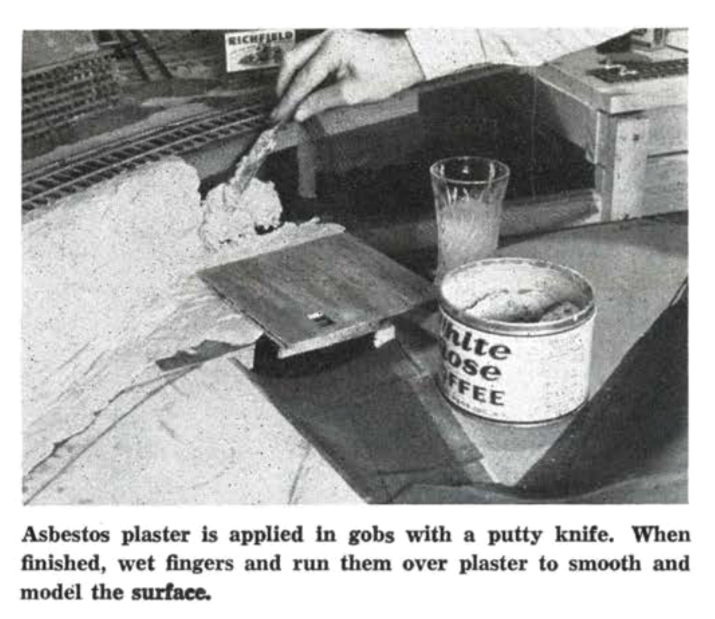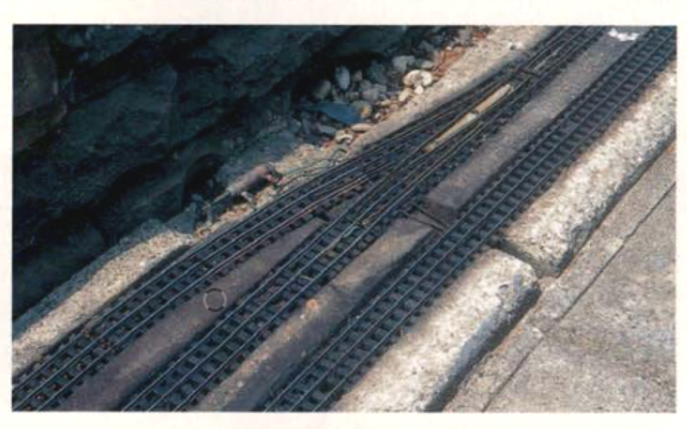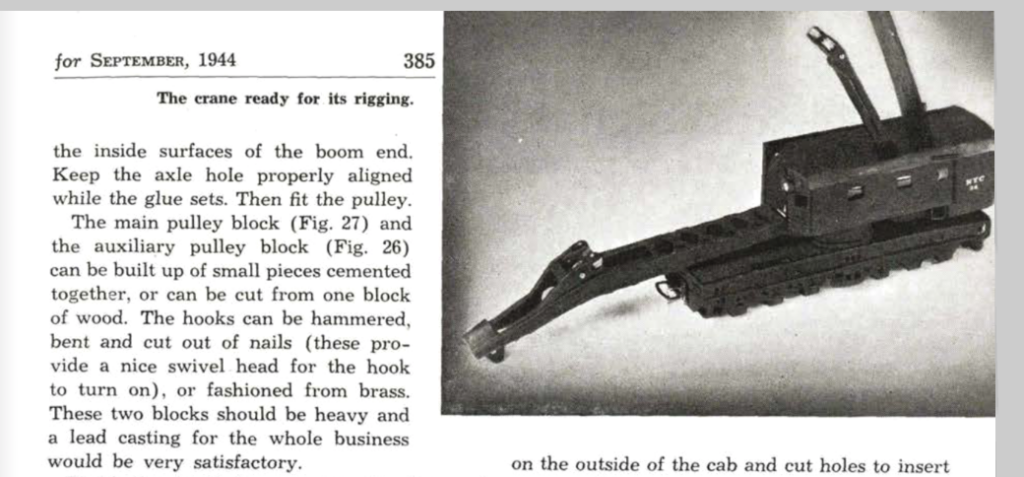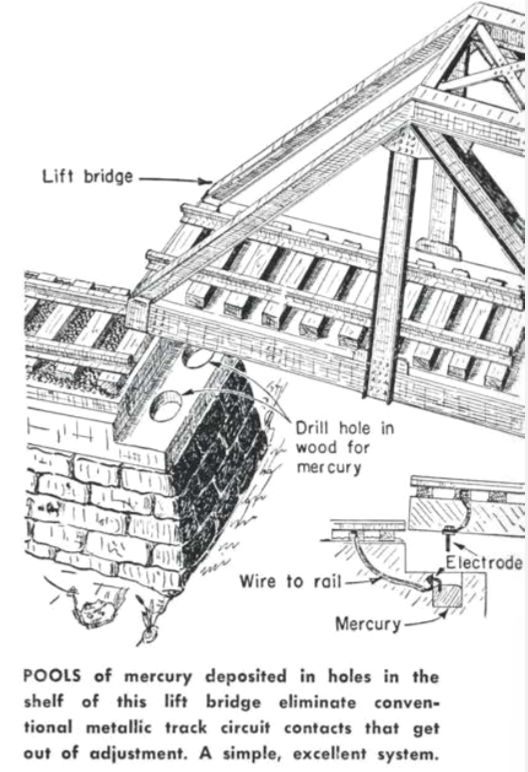Can you believe hobbyists used to use toxic chemicals on model railroads? In the days before hobby shops sold premade scenery and wiring products, hobbyists made their own. Unfortunately, some of the materials weren’t very safe.
Note: We’re providing this article for information and entertainment only. We are definitely not endorsing any of these substances for hobby use.
Asbestos
 The use of asbestos dates back thousands of years. The Egyptians used asbestos cloth to wrap and protect the bodies of deceased Pharaohs. The malleable properties of the substance made it an important building and binding commodity, and it was used in a plethora of products from cement, wiring insulation, and automobile brake pads. There were even some roadways made with asbestos-laced asphalt! In the late 1970s, there was a dramatic reduction in its commercial use because of its connection to lung diseases.
The use of asbestos dates back thousands of years. The Egyptians used asbestos cloth to wrap and protect the bodies of deceased Pharaohs. The malleable properties of the substance made it an important building and binding commodity, and it was used in a plethora of products from cement, wiring insulation, and automobile brake pads. There were even some roadways made with asbestos-laced asphalt! In the late 1970s, there was a dramatic reduction in its commercial use because of its connection to lung diseases.
As you might guess, model railroaders used to use asbestos in making scenery. Some modelers used powdered asbestos, dyed green, as ground cover. It was also a popular ingredient in plaster. In the article “50,000 Spikes,” from the April 1942 Model Railroader, author George Allen suggests using a wet finger to smooth asbestos plaster.
Creosote oils

Creosote is formed by the distillation of tars from wood or fossil fuels. The name “creosote” has a broad range of definitions depending on the origin of the oil and the end-use of the material. Coal-tar creosote is used as a preservative on a variety of woods, including ties, telephone poles, and fence posts. Due to its carcinogenic properties, the U.S. Environmental Protection Agency (EPA) lists creosote oils as a restricted-use pesticide.
Because of its preservative properties, it’s not surprising that garden railroaders found creosote useful. Paul Lieszkovsky, who had an outdoor O gauge line in the August 2000 Garden Railways, soaked his GarGraves track in creosote every two years. Despite it being illegal to put creosote to that kind of use, Paul stated that he hadn’t found another preservative “that satisified him.”
Lead
Lead was one of the earliest metals discovered by humans, and was in use by 3,000 B.C. The Romans used lead for lining water pipes and baths. It was also popular in winemaking.
Because it is soft and malleable, lead was used in a plethora of products, including bullets, plumbing products, paint, and children’s toys. Lead is a highly poisonous metal, affecting nearly every organ in the body. Regulations in the U.S. reduced or eliminated lead from non-battery products (paint, gasoline, solders, and water systems). Lead is still commonly used in construction products and lead-acid batteries.
Dr. Richard C. Mast, in the September 1944 MR, scratchbuild a 200-ton crane. He cast detail parts from lead blocks!
Mercury
Similar to asbestos, mercury use dates back to the Egyptians, where it’s been found in tombs dating back to 1,500 B.C. In China and Tibet, it was thought to have healing properties. In commercial use, mercury was commonly used in dental amalgams (fillings) and in household thermometers. The Clean Air Act, passed in 1990, put mercury on a list of toxic pollutants that need to be controlled “to the greatest possible extent.”
Some hobbyists used mercury as an electrical contact. In the July 1948 MR, Billings McArthur of Chicago shared how he used two pools of mercury to electrify his lift bridge.
Toxic chemicals on model railroads–today
Fortunately, we have much safer materials to use on our model railroads today. But some tools and materials – hobby knife blades, rotary tools, solvent-based paints and cements, aerosols, and hot solder – can still cause illness and injury. Always use personal protective equipment and take proper safety precautions when modeling.
















In Jr.High school in the 1950’s, we always played with mercury balls on our desks in science class, and had rolls of asbestos paper to spread under the Bunson burner.
Both points are quite correct. Stripping paint from a vintage model, handling metal castings and any other unknowns is best done with nitrile or similar gloves. An old partially lead detail part is less harmful once sealed under paint, but you don’t want to transfer any of that content to your skin or mouth. Always wash your hands. The asbestos paste made sense for scenery in the days before fiber dust was determined to be so harmful. It was worked like Sculptamold and easily available. Furnace guys spread it all over joints to seal them and wrapped the pipes with asbestos cloth that you put on wet like plaster impregnated gauze. Seems perfect for train use. In theory, if not disturbed (you can never tear the layout down…) and sealed with paint and scenery it would be OK. Thankfully, we have MUCH better and safer materials today!
Unfortunately, what this article failed to mention (and should have) is that there are still models of locomotives and cars that use lead and other hazardous materials in their design. Bachmann is one of the worst offenders since a lot of their locomotives and cars still use lead-based paint. On my Bachmann Spectrum N-scale model of N&W 611 and the three streamlined passenger cars that are in N&W livery (baggage, chair, and observation) that it pulls, for example, the little slips for the jewelry-style cases that they’re presented in mention the p65 warning label that these products contain lead. Even Bachmann’s products that are marketed to younger entrants to the hobby, such as those in their Thomas and Friends product line (including the new N-scale Thomas products), have this problem. I’m not surprised given that Bachmann still produces a lot of their products in China because they’re the Bermuda-registered US (and UK) subsidiary of the Kader Group. Anyway, that’s one thing that this article didn’t mention but should have.
Still the odd white metal casting that might have traces of lead, but that will probably become more of a niche product as improvements in fine scale part making progress.